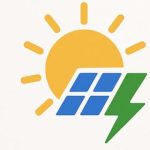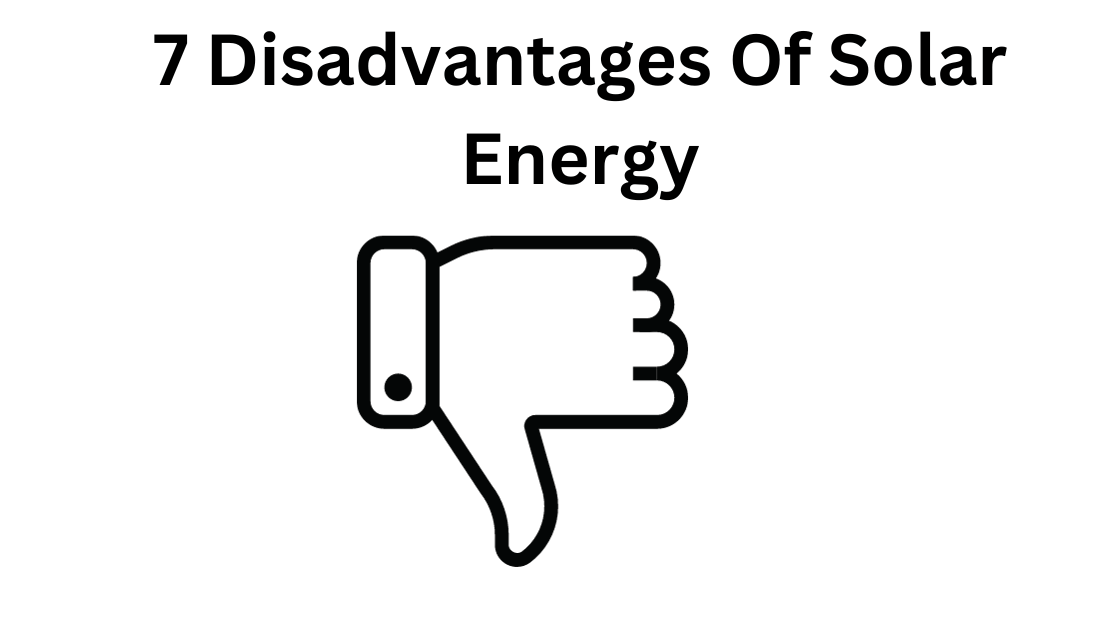There are countless advantages to having solar energy in your home or business. I’m personally an advocate of solar energy because of the long-term savings, environmental benefits, and independence it can offer.
However, no energy solution is perfect. Solar power comes with its own set of drawbacks that are important to understand before making the decision to install panels.
7 Disadvantages of Solar Energy
In this post, I’ll share with you 7 disadvantages of solar energy so you can have a clear, balanced view and be fully informed before investing.
It Produces Intermittent Energy
Solar panels generate electricity only when there is sunlight. That means during the night, or on heavily overcast days, the energy production is minimal or even nonexistent.
This makes solar inherently intermittent. It doesn’t produce a consistent flow of power throughout the day or year.
Another key factor is temperature. While it might sound logical to think more sun and heat equals more energy, in reality, higher temperatures actually reduce the efficiency of solar panels.
Panels work best at moderate temperatures, and in very hot climates, the efficiency can drop noticeably.
Other factors that reduce production include shading from nearby trees or buildings, the angle of the sun throughout the year, and dirt or dust accumulation on the panels. All of these affect output, sometimes significantly.
To combat intermittency, many people install grid-tied solar systems. These allow you to use solar power during the day and pull from the grid when your panels aren’t producing.
The catch is that most grid-tied systems automatically shut down if the main power grid goes out, leaving you without electricity during blackouts.
The other option is to install a standalone system with batteries, so you can store excess energy for use at night or during cloudy periods.
While this solves the problem, it’s also very expensive. Batteries alone often account for up to 60% of the total project cost, which makes them inaccessible for many families and small businesses.
Geographic Limitations
Not every location on Earth is suitable for solar power. Some regions enjoy abundant sunshine all year round, making solar a very practical option.
But in other places, especially those closer to the poles or areas with long rainy or snowy seasons, the available sunlight may only last two to three months of the year.
In these cases, relying solely on solar power isn’t realistic. There are even areas where daylight is limited to just a few hours per day during winter months, which makes solar installations highly inefficient.
Additionally, extremely hot climates pose challenges too. As mentioned earlier, high heat lowers solar panel efficiency.
While manufacturers have developed panels with lower temperature coefficients to handle these conditions better, they are more expensive, pushing up the overall cost of the system.
In short, the effectiveness of solar is heavily tied to your location. If you live in an area with limited sunshine or extreme temperatures, solar may not provide the results you expect.
High Initial Installation Costs
Installing solar panels is not a small expense. It’s often ranked among the top three lifetime purchases, right alongside buying a home or a new car.
For a standard family home, the installation can cost anywhere from $15,000 to $22,000 depending on system size, equipment quality, and labor costs.
For lower-income or middle-class families, this upfront expense can be a major barrier to adopting solar energy, even though the system can eventually pay for itself through savings.
The positive side is that many governments and local authorities now offer tax credits, rebates, and grants to help reduce the initial costs.
While these incentives can make solar more accessible, the reality remains that the upfront investment is still high and not affordable for everyone.
Storage Challenges
One of the biggest hurdles facing solar energy today is energy storage. To achieve complete independence from the grid, you need batteries that can store enough electricity to power your home during nights, cloudy weeks, or even entire seasons without sunshine.
Unfortunately, the technology for long-term storage isn’t here yet. Current batteries are designed to store energy for short periods, typically a day or two at most.
Storing energy for 3 to 9 months, which would be necessary in places with long winters or rainy seasons, is simply not feasible with today’s options.
And even if technology allowed it, the cost of batteries is still extremely high. For many households, the expense of a full storage system is unrealistic.
This limitation means that, in practice, most solar users still depend on the grid for backup, limiting the independence solar energy can provide.
Environmental Concerns
Solar energy is often described as a clean, renewable alternative to fossil fuels—and for the most part, that’s true. But it’s not entirely free from environmental impact.
The production of solar panels requires materials like lead, cadmium, and gallium arsenide. These substances are toxic and, if not handled and disposed of properly, can contaminate soil and water.
While efforts are being made to improve recycling and reuse processes, the industry is still far from completely sustainable.
Additionally, the manufacturing process of panels consumes energy and resources, which contributes to carbon emissions.
Over their lifetime, panels offset these emissions by producing clean energy, but it’s important to recognize that solar energy is not 100% impact-free.
Reliability Issues
Solar panels depend on a number of external factors to work efficiently: sunlight availability, temperature, angle of installation, presence of dust or debris, and potential shading from obstacles.
This makes them less reliable in certain applications where constant, uninterrupted energy is critical.
For instance, industries like hospitals, factories, or data centers cannot afford fluctuations in power supply. A cloudy day or sudden storm could compromise production or even safety.
The solution is usually to combine solar with the grid (or with large storage systems). However, connecting to the grid often requires special permissions, additional infrastructure like net meters, and added costs.
On the other hand, relying on batteries to ensure reliability is also expensive and, as we’ve seen, not practical for everyone.
Limited Lifespan
Many solar companies market solar panels as a “lifetime investment.” While it’s true that they can last for decades, they don’t last forever.
Most solar panels come with a warranty of 20 to 30 years. After that, their efficiency gradually decreases until they may no longer be worth keeping.
Even though this lifespan is long enough to cover the initial investment, most solar systems have a payback period of 7 to 10 years, meaning you could still enjoy 10 to 15 years of essentially free electricity. It’s important to factor in that the system will eventually need replacement.
This means future costs may be necessary if you want to continue benefiting from solar energy for the rest of your life.
FAQ: 7 Disadvantages of Solar Energy
What is the biggest disadvantage of solar energy?
The biggest disadvantage is the high upfront installation cost, followed closely by the limitations of battery storage.
Are solar panels really worth it despite these disadvantages?
Yes, in many cases. If you live in a sunny region and plan to stay in your home for at least 10 years, solar panels usually pay for themselves and then provide free electricity.
How long do solar panels really last?
Most panels last 20–30 years with proper maintenance, though efficiency gradually decreases over time.
Do solar panels work in cloudy or cold climates?
Yes, but they produce less energy. Cloudy weather and limited sunlight hours reduce output, making solar less effective in some regions.
What about the environmental impact of solar panels?
While cleaner than fossil fuels, solar panel production involves hazardous materials and energy-intensive processes. Recycling efforts are improving, but sustainability remains a concern.
Final Words
These are the 7 disadvantages of solar energy you should consider before installing a system. This doesn’t mean solar panels are a bad investment.
In many cases, they’re an excellent one. But being aware of the challenges helps you make a more informed, confident decision.
If you’re considering going solar, make sure to ask installers the right questions, check your local conditions, and evaluate whether solar truly fits your household or business needs.

